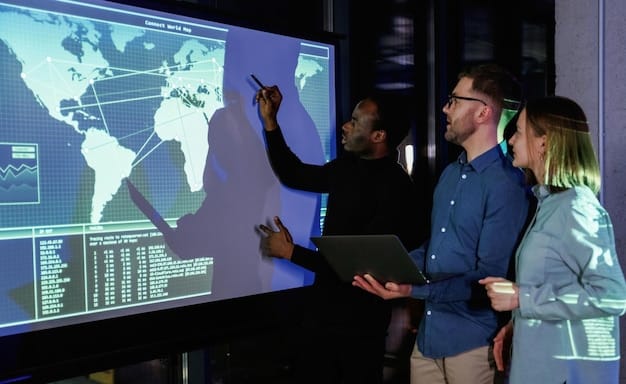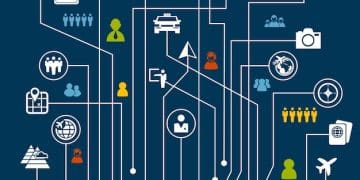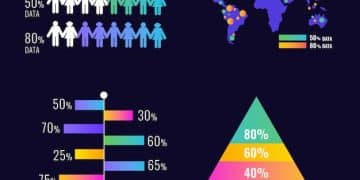Timeless Reports: Navigating Geopolitical Risks in 2025 – A Definitive Guide

Timeless Reports: The Definitive Guide to Understanding and Navigating Geopolitical Risks in 2025 provides businesses and individuals with crucial insights and strategies to anticipate, assess, and mitigate the complex geopolitical challenges of the coming year.
The world in 2025 is poised to be a complex tapestry of shifting alliances, economic uncertainties, and technological disruptions. Timeless Reports: The Definitive Guide to Understanding and Navigating Geopolitical Risks in 2025 offers a comprehensive analysis of these challenges, providing actionable insights to mitigate potential disruptions.
Understanding the Evolving Geopolitical Landscape
The geopolitical landscape is constantly shifting, influenced by a multitude of factors. Understanding these dynamics is crucial for businesses and individuals alike to make informed decisions and mitigate potential risks. Several key trends are shaping the global order, demanding careful attention.
The Rise of Multipolarity
The decline of a unipolar world dominated by a single superpower is giving way to a multipolar system. This evolution involves several major powers vying for influence, leading to increased competition and potential for conflict. Understanding the interests and strategies of these different actors is essential.
Increasing Technological Disruption
Technological advancements are rapidly transforming industries and societies. While offering immense opportunities, they also create new vulnerabilities and challenges. Cybersecurity threats, data privacy concerns, and the weaponization of technology are becoming increasingly prominent geopolitical risks.
- Analyzing the impact of 5G and future communication technologies on international relations.
- Evaluating the cybersecurity landscape and identifying potential threats to critical infrastructure.
- Assessing the ethical and geopolitical implications of artificial intelligence.

These forces affect international trade relations, increase the frequency of cyber-attacks, foster misinformation campaigns; all of these require strategies to be developed that must deal with these complications. The necessity of the decision-making processes which encompass diverse circumstances become greater.
Key Geopolitical Risks to Watch in 2025
As we move into 2025, certain geopolitical risks loom large on the horizon. These potential crises demand careful monitoring and strategic planning to minimize their impact. From regional conflicts to global economic uncertainties, preparedness is key.
Regional Conflicts and Instability
Several regions around the world are experiencing heightened tensions and conflicts. These include ongoing disputes over territory, resources, and political ideology. Understanding the root causes of these conflicts and their potential escalation is crucial.
Economic Sanctions and Trade Wars
Economic sanctions and trade wars have become increasingly common tools of foreign policy. These measures can have significant impacts on global trade, supply chains, and economic stability. Businesses need to be aware of the potential risks and opportunities created by these policies. For example, how could US sanctions against Russia be expected to affect the ability to do business between countries.
- Analyzing the potential for increased trade tensions between the US and China.
- Evaluating the impact of sanctions on specific industries and sectors.
- Developing strategies to mitigate the risks associated with trade wars and protectionist policies.
Understanding possible conflicts ahead of time is going to be key for investors and people involved in businesses. As a result of these problems, companies must be flexible which enables them to adjust to these challenges.
Cybersecurity Threats and Digital Warfare
Cyberattacks are becoming more sophisticated and frequent, posing a significant threat to businesses and governments. Digital warfare can disrupt critical infrastructure, steal sensitive information, and undermine national security. Investing in robust cybersecurity measures is essential to protect against these threats.
Assessing Geopolitical Risks: Frameworks and Methodologies
There are frameworks and methodologies that can be very beneficial, for those who want to effectively assess geopolitical risks. These tools can help organizations to evaluate possible scenarios, pinpoint vulnerabilities and create mitigation tactics. A comprehensive approach will improve resilience and adaptability to challenges in a global environment.
Political Risk Analysis
Political risk analysis is a crucial tool for assessing the potential impact of political events on business operations. This involves evaluating political stability, regulatory changes, and potential for corruption. Using these analyses, firms might better understand and operate within complicated environments while protecting their interests.
Scenario Planning
Scenario planning involves developing multiple plausible scenarios for the future and assessing their potential impact. This helps organizations to prepare for a range of potential outcomes and develop flexible strategies. This means exploring several pathways to be followed which can prove to be beneficial.

- Developing a framework for identifying and prioritizing geopolitical risks.
- Using data analytics to track and monitor emerging threats.
- Creating contingency plans to mitigate the impact of geopolitical events.
With the help of this advance planning, firms are ready to deal with uncertainties and will have prepared themselves to confront geopolitical dangers even while operating safely in various geopolitical settings.
Strategies for Navigating Geopolitical Risks
Navigating geopolitical risks requires a proactive and strategic approach. Organizations must develop robust risk management plans, build resilient supply chains, and engage with stakeholders to mitigate potential disruptions. Adaptation and preparedness are crucial for long-term success.
Diversifying Supply Chains
Relying on a single supplier or region can create vulnerabilities in the face of geopolitical risks. Diversifying supply chains can reduce these risks and improve resilience. To achieve this, sourcing from different geographic zones gets paramount to decreasing susceptibility to supply chain failures.
Building Strong Stakeholder Relationships
Engaging with stakeholders, including governments, communities, and industry associations, is essential for mitigating geopolitical risks. Building strong relationships can help organizations to anticipate and respond to emerging threats. Strong ties with many partners is necessary for the organization to remain updated and flexible.
These tactics can help firms to stay ahead and minimize any possible unfavorable aftermath in the face of rising world tensions. Companies that adopt these proactive strategies become better equipped to deal with uncertainty while still ensuring the security of operations.
The Role of Technology in Mitigating Geopolitical Risks
Technology can play a crucial role in mitigating geopolitical risks, there are several ways in which technology can be deployed. These involve improved risk assessment tools, more effective communication strategies as well as increased capabilities to identify and counter threats. By making the most of innovation, establishments can ensure that they navigate ever changing settings more safely.
Cybersecurity Solutions
Investing in robust cybersecurity solutions is essential for protecting against cyberattacks and digital warfare. These solutions should include firewalls, intrusion detection systems, and data encryption. For the safety of sensitive information and ensuring the permanence in operations, establishing security measures is pivotal.
Data Analytics and Risk Monitoring
Data analytics can be used to track and monitor emerging geopolitical risks. By analyzing data from various sources, organizations can identify potential threats and take proactive measures to mitigate their impact. Data analytics can give crucial information that is instrumental making decisions and strategy of risk management.
Organizations are better positioned to forecast coming challenges and to set up responsive security actions to be put in place once they start considering technologically advanced solutions. In today’s interconnected economy, the use of technology with respect to risk reduction isn’t a guarantee of achievement but it could potentially mean the distinction between weakness and strength.
Preparing for 2025: A Proactive Approach
As firms gear up for 2025, the key is to take a proactive strategy encompassing preparation, flexibility and risk controlling. Organizations which get into this attitude are going to be better prepared to deal with upcoming geopolitical shocks.
Continuous Monitoring and Assessment
Geopolitical risks are constantly evolving, so it is essential to continuously monitor and assess the landscape. This involves staying informed about current events, tracking emerging trends, and regularly updating risk assessments. Keeping up-to-date means an ability to handle the ever-changing world environment.
Investing in Resilience
Building resilience is essential for navigating geopolitical risks. This involves diversifying supply chains, strengthening cybersecurity measures, and developing contingency plans. With such efforts, entities may withstand disruptions and quickly retrieve while experiencing minimal impacts.
| Key Point | Brief Description |
|---|---|
| 🌍 Geopolitical Shifts | Changes in international alliances and power dynamics impacting global stability. |
| 🛡️ Risk Assessment | Importance of comprehensive risk assessment methodologies. |
| 💡Strategic Navigation | Strategies for navigating the geopolitical landscape which include diversifying the supply chains, strengthening bonds with essential stakeholders. |
| 🚀 Tech Mitigation | Use of technological solutions is helpful with handling geopolitical hazards like data analytics as well as cybersecurity measures. |
Frequently Asked Questions
▼
Key risks include regional conflicts, economic sanctions, cybersecurity attacks, and political instability. These risks can impact global trade, supply chains, and business operations.
▼
Businesses can use political risk analysis, scenario planning, and data analytics to assess geopolitical risks. These tools help evaluate potential impacts and develop mitigation strategies.
▼
Strategies include diversifying supply chains, building strong stakeholder relationships, and investing in cybersecurity. These measures enhance resilience and adaptability.
▼
Technology provides cybersecurity solutions, data analytics for risk monitoring and communication capabilities. This in turn helps organizations in threat identification as well as counter measures.
▼
A proactive approach involves continuous monitoring, regular assessments, and investing in resilience. It allows businesses to anticipate and prepare for potential disruptions effectively.
Conclusion
In conclusion, the “Timeless Reports: The Definitive Guide to Understanding and Navigating Geopolitical Risks in 2025” ensures that you have a thorough understanding and strategy to deal with the complexities and also the uncertainties of the geopolitical landscape. By employing proactive measures, investing in resilience, and utilizing technology effectively, businesses and individuals can confidently navigate the challenges and opportunities of the coming year.





